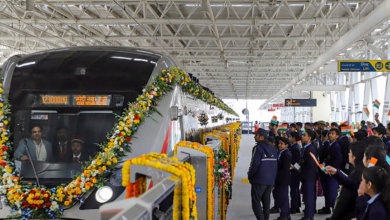Clear air could possibly be a robust financial enhance for India – evaluation
Clear air must be a primary human proper and but air air pollution is the one biggest environmental threat to human well being. In 2017, 3.four million folks died prematurely on account of outside air air pollution which makes 6% of world deaths. The share for India was 8.26%. The World Well being Group (WHO) ranked New Delhi because the world’s most polluted metropolis in 2014.
The Covid-19 pandemic made city air air pollution a extremely seen drawback. As cities declared lockdowns, folks in lots of highly-polluted cities noticed the blue skies and lots of of them realised for the primary time what the world would possibly seem like if the air was clear. Public notion surveys because the pandemic reveal that contemporary air has triggered many to rethink a return to “regular”. There’s a transparent demand for greener areas in cities, elevated public transportation, make money working from home and penalising the polluters. The sharp drop in air air pollution throughout the pandemic has additionally created a larger consciousness of the well being impacts and vulnerability to threats like Covid-19 attributable to airborne pollution.
Whereas India develops its financial restoration plans, it’s important to incorporate measures to scale back air air pollution. The lockdown has proven us how shortly the air could possibly be cleaned up if main air pollution sources are correctly managed. Nonetheless, to make such optimistic change everlasting we have to begin addressing the sources of air air pollution at a systemic stage.
An space of apparent concern is automotive emissions. The drastic drop in transport emissions throughout the lockdown was evident when cities throughout India recorded a 65-70% discount in nitrogen dioxide (NOx) concentrations—a pollutant immediately attributable to inside combustion engines. On the similar time, India has the world’s second-largest highway community, and with the present fee of progress, the whole variety of autos is projected to double by 2030. A continual level of competition has been the growth of roads to accommodate extra automobiles. Vehicles are an inefficient mode of transport and use of public house as they waste over 50% of their carrying capability and are parked for nearly 90% of the time. Doubling automotive numbers may deliver much more insufferable visitors, air air pollution and costly further highway infrastructure.
One apparent answer is the two- and three-wheelers which now account for almost 84% of the county’s annual auto gross sales and highway transport quantity. They fare a lot better on carrying capability as effectively—particularly three-wheelers utilized in public transport. Their counterparts, the electrical rickshaws, have emerged as a transparent winner for the last-mile connectivity throughout a lot of city India since their fares are additionally 30% cheaper. They aren’t solely cleaner but in addition quieter.
Electrical public transport additionally ties in with what must be India’s long-term focus: Creating inexpensive and comfy options for longer distances. Taking inspiration from Delhi’s glorious metro rail, Pune, Navi Mumbai and Nagpur at the moment are additionally creating their very own metro strains. Commuter comfort may be additional enhanced by state governments increasing their fleets of electrical buses and introducing laws and incentives for electrical rickshaws, taxis and metropolis supply autos. All of them have zero on-road emissions, are cheaper to entry, and considerably extra environment friendly in shifting folks round than personal automobiles.
By way of micro-mobility, research recommend that 71% of all journeys in India occur inside a radius of 5 km. These may be simply serviced by electrical two- and three-wheelers, which might do a number of runs per cost at a low price, even with commonplace battery packs of 70-80 km capability. They’ll function along with a deal with city redesign that features extra bicycle lanes. You will need to maintain prolonged public discussions between residents of areas with heavy visitors and metropolis planners, in order that redevelopment takes under consideration what non-car house owners need. The programmes corresponding to CyclesforChange, launched collectively in Chennai by the Institute for Transportation Growth and Coverage (ITDP) and the Centre’s ministry of housing and concrete affairs to encourage extra intra-city bicycle journeys, are important steps in the fitting route.
The expertise of many European cities exhibits that shifting from heavy automotive visitors to predominantly pedestrian, bicycling and public transport mobility is commonly met initially by the hostility of residents, store house owners and drivers however as soon as the modifications are in place folks admire the brand new preparations. Outlets profit from pedestrians that may cease and enter simply, the air is cleaner, life is more healthy.
Nonetheless, it’s also necessary that decreasing transport emissions is coupled with clear sources of power. As extra renewable power enters the market, the air pollution load of charging EVs will decline nationally, not simply regionally. As a part of state EV insurance policies, state governments ought to incentivise that charging stations and battery swapping factors are powered by renewable power. The UK and different nations are introducing the apply of charging stations declaring what the power supply is. In India, some states like Telangana and Tamil Nadu, are already setting an instance with diminished energy tariffs for the EV charging infrastructure.
Insurance policies for bold electrification of metropolis transport may even have a robust financial profit by boosting battery and electrical car manufacturing. It will possibly create demand that might catalyse the Nationwide Mission on Transformative Mobility and Battery Storage and transfer India ahead within the fierce world competitors within the subject of power storage and new mobility. This could possibly be an space of explicit curiosity for worldwide cooperation with the European Union (EU) and a few of the most bold EU nations in these sectors corresponding to Germany and France.
Total, the response to recovering after the pandemic has proven that native, collective motion has the facility to implement change. A really inexperienced restoration ought to permit folks to avail the cleanest, most inexpensive modes of journey, which is the place e-mobility and public transit options are necessary. With on-road economics beginning to tilt irreversibly of their favour, governments would thus do effectively to prioritise demand-side funding of recent mobility over business-as-usual.
Julian Popov is a former minister of atmosphere of Bulgaria, a fellow of the European Local weather Basis and chairman of the Constructing Efficiency Institute Europe
The views expressed are private
Source link




